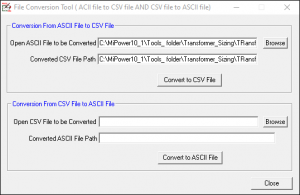- Supports both MKS (Metric) and FPS (Imperial)
- Picks between single or double circuit line configurations.
- Customize conductor properties (bundling, spacing, diameter, position).
- Outputs include Inductance, Capacitance, GMD, GMRL, and GMRC.
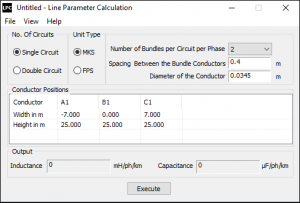
- Modeling lines as short, medium, or long based on length.
- Configurable Sending/Receiving end kV, δ, MW, MVAR and Receiving end admittance data.
- Outputs:
- ABCD constants.
- Line kV per km.
- View sending-end voltage and current phasors, along with MW and MVAR values.
- Display power factor, voltage regulation (%), and efficiency (%) for both sending and receiving ends.
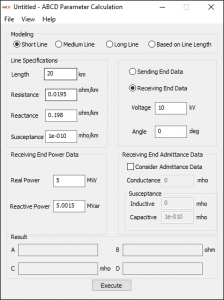
- Select cost function: normal or incremental fuel cost.
- Set total demand, number of generators, and convergence criteria for lambda-iteration method.
- Configure generator limits, cost data, and B-coefficient matrix.
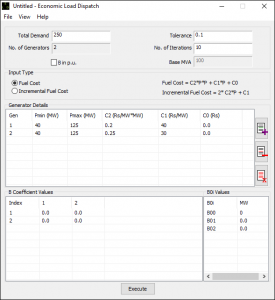
- Analyse dynamic stability with a two-machine system example.
- Customize Parameters (like machine data, infinite bus voltage, system frequency, transformer reactance and line reactance).
- Accepts Multiple input Kd and δ Values.
- Outputs dynamic coefficients and angular frequency.
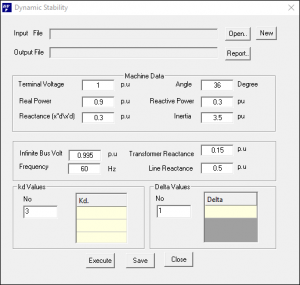
- Select study type: Y-Bus formation Y-Bus & Z-Bus formation, or Voltage by Current Injection.
- Provides fields to define full system specifications, including the number of elements and their details.
- Outputs Y-Bus, Z-Bus matrices and bus voltages (along with V ∠θ° for all buses).
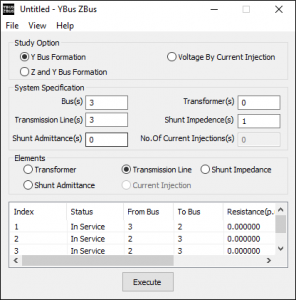
- Choose single or multi-area LFC (Load Frequency Controllers).
- Allows customization of simulation settings and area-specific details.
- Analyses how single-area frequency responds to demand changes, with or without load frequency controllers (LFCs).
- Analyses multi-area frequency and tie-line flow response when demand changes in one area.
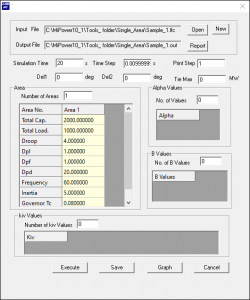
- Choose salient or non-salient pole machines.
- Configure generator rating, voltage, PF (Power Factor) and d-q axis reactance.
- Output results in machine power angles (δ) with corresponding electrical and reluctance power (MW).
- Includes an optional graph to visualize power vs. power angle for better understanding.
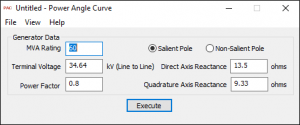
- Configure line impedance, length, receiving end power, PF (power factor), and voltage.
- Computes sending-end voltage, max real power, and power circle parameters.
- Includes power circle graph (MW vs. MVAR).
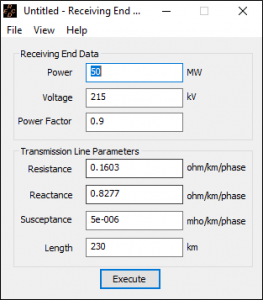
- Set voltage, current and input power values for no-load and short-circuit conditions.
- Calculates motor parameters based on rated input and stator/rotor resistance ratio.
- Shows full-load motor values, including maximum input power, output power, and torque.
- Provides a graph of the induction motor circle diagram (Real vs. Reactive power).
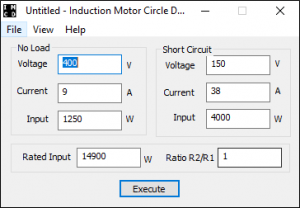
- Customize matrix size (rows and columns) and scaling factor.
- Define cost coefficient variables and their values for each column.
- Set upper and lower limits with tolerances for each row.
- Shows results including convergence status, objective function value, and linear programming solution.
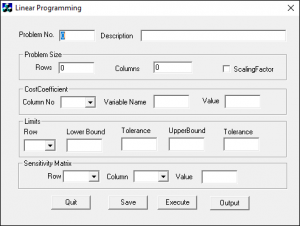
- Set the number of variables along with their units and initial values.
- Define coefficient matrices [A] and [B].
- Choose from solver methods like Euler’s, Modified Euler’s, or Runge-Kutta.
- Solves differential equations using the formula [x’] = [A] [x] + [B].
- Calculates values for each variable at every time step.
- Displays a graph showing variable values over time.

- Set basic system details including the number of elements and their specifications.
- Choose from various load flow methods like Gauss-Siedel (GS), Newton-Raphson (NR), or Fast Decoupled Load Flow (FDLF).
- Customize study parameters as needed.
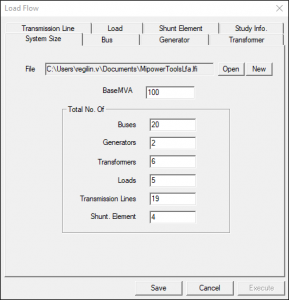
- Input basic system and fault data.
- Simulate different fault types (LLLG, LLG, LG and LL).
- Analyse faults at single/multiple buses with reactance (transient/sub-transient)
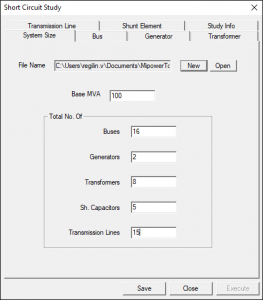
- Calculate critical clearing angle using TRS file inputs.
- Set fault clearing time, simulation times and study parameters.
- Generates a detailed report of the critical clearing angle, along with an output file for the MiPower TRS module and a graphical plot for easy analysis.
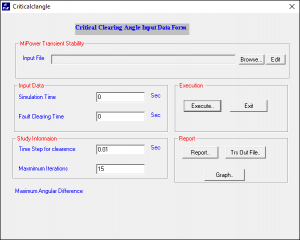
- Customize generator details such as power limits, cost coefficients, uptime/downtime, status, and start-up settings.
- Define hourly load inputs including power demand and reserve capacity.
- Select reserve type: Fixed, User Defined, or Percentage of Load.
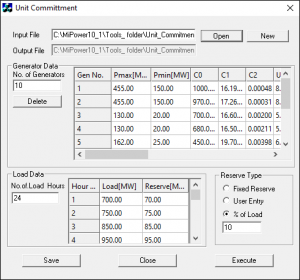
- Set the number of generators and load hours as needed.
- Define generator details including power limits, cost coefficients, uptime/downtime, status, and start-up settings.
- Choose the generator cost curve type: Linear or Quadratic.
- Input hourly load data such as power demand and reserve capacity.
- Select the reserve type: Fixed, User Defined, or based on Percentage of Load.
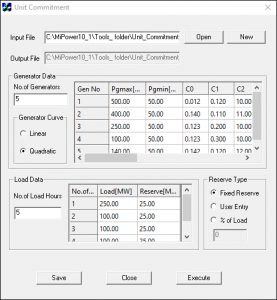
Accordion Content
- Calculates transformer size based on its specifications and environmental conditions.
- Supports standard options: IEEE, IEC, and IS.
- Allows configuration of transformer details like HV/LV voltages, winding type, insulation (liquid/dry), cooling class, and temperature rise.
- Set installation altitude, ambient temperature, load info, and load variation factors.
- Configure HV/LV short circuit currents and Basic Insulation Level (BIL).
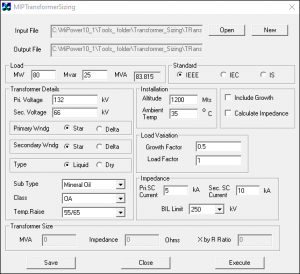
- Set reservoir details including storage limits and initial/final water levels.
- Configure hydro unit information such as unit count, power limits, output, and status.
- Use power production libraries with various volumetric flow rates and corresponding power outputs.
- Enter thermal unit details like power limits, ramp rates, initial generation, unit status, and starting parameters.
- Define thermal cost functions with multiple power outputs and corresponding costs.
- Input hourly demand and water inflow data.
- Economic Load Dispatch (ELD) for both hydro and thermal power plants.
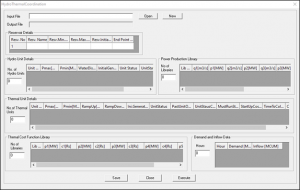
- Easy-to-use cable data editor with fully customizable input fields and settings.
- Supports both MKS (Metric) and FPS (Imperial) unit systems.
- Calculates cable ampacity based on user-defined ambient temperature (°C) limits and step size.
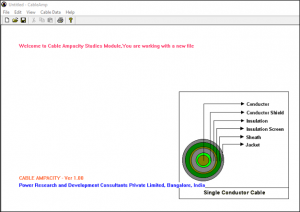
- Calculates project feasibility, net cash flow, and return on investment.
- Determines the payback period.
- Computes the project’s interest rate.
- Provides present worth results in a text format.
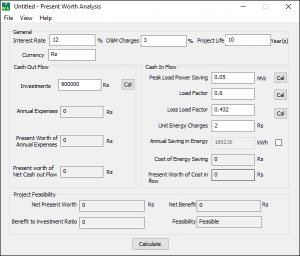
- Convert between ASCII (text) and CSV (Excel) formats for data handling.
